Text
'She is so old': One-eyed wolf in Yellowstone defies odds by having 10th litter of pups in 11 years
By Patrick Pester, published June 3, 2024
Wolf 907F recently gave birth to her 10th litter of pups, which researchers say is likely a Yellowstone National Park record.
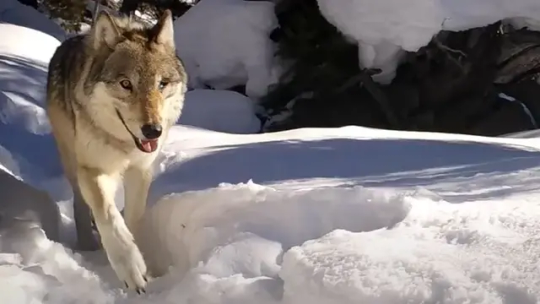
Wolf 907F walking past a trail camera in Yellowstone National Park. (Image credit: Yellowstone Wolf and Cougar Project)
The alpha female of a Yellowstone gray-wolf pack has defied the odds by having a 10th litter of pups at the age of 11.
The one-eyed wolf elder, named Wolf 907F, gave birth to her latest litter last month, the Cowboy State Daily reported. Gray wolves (Canis lupus) have an average life span of three to four years, so it's rare for them to reach 11, let alone have pups at that age.
Wolf 907F has given birth to pups every year for a decade straight since she became sexually mature, which Kira Cassidy, a research associate at the Yellowstone Wolf Project, said is likely a record for the wolves of Yellowstone National Park.
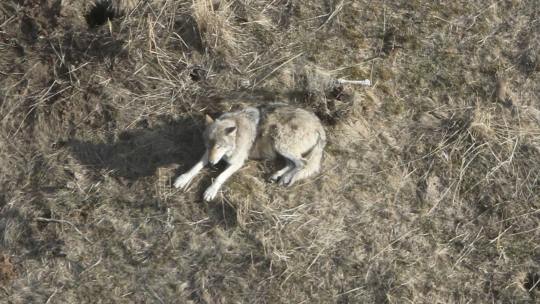
At age 11, Yellowstone’s Wolf 907F has lived more than twice a wild wolf’s average life expectancy. In this photo from April, she was pregnant with a litter of pups that she’s since given birth to. (Courtesy Yellowstone Wildlife Project)
"Every day, I expect that she might die just because she is so elderly, but I've been thinking that for the last few years, and she keeps going," Cassidy told Live Science.
Cassidy has calculated that only about 1 in 250 wolves in Yellowstone make it to their 11th birthday, with just six recorded examples since wolves were reintroduced to the park in 1995. The oldest of all of these great elders lived to 12.5 years, according to the National Park Service.
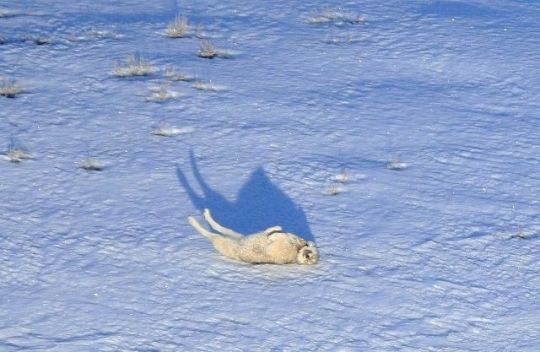
Wolf 907F lies in the snow in Yellowstone in 2015. (Image credit: Kira Cassidy/NPS)
Wolf 907F is the oldest wolf to have lived her whole life in the park's Northern Range, where there is more prey but also more competition from other wolves. Wolves rarely die of old age in the wild, and in Yellowstone National Park, the biggest threat is other wolves.
"In a protected place like Yellowstone, their number-one cause of death is when two packs fight with each other," Cassidy said. "That accounts for about half of the mortality."
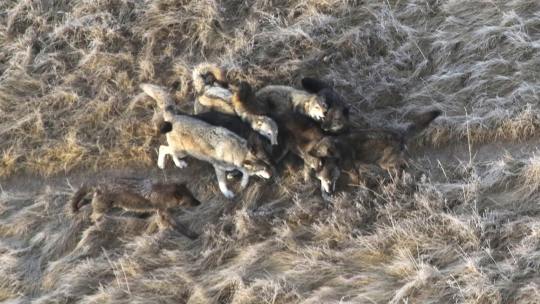
One of Yellowstone's oldest wolves, Wolf 907F is pictured here with her pack last year. She's the gray collared wolf on the lower left. (Courtesy Yellowstone Wildlife Project)
Wolf 907F is the alpha female of the Junction Butte pack, which has between 10 and 35 members at any given time. Cassidy noted that this is a large pack — the average wolf pack size is about 12 individuals — and that reduces the risk of being killed in territorial fights. Wolf 907F's experience also gives her pack an edge.
"Packs that have elderly wolves are much more successful in those pack-versus-pack conflicts because of the accumulated knowledge and the experience that they bring to that really stressful situation," Cassidy said.
Wolf 907F has likely boosted her pack's survival chances outside of battle, too. Cassidy noted that the Junction Butte pack rarely leaves Yellowstone's border and that Wolf 907F is "savvy" when it comes to things like crossing roads and avoiding humans.
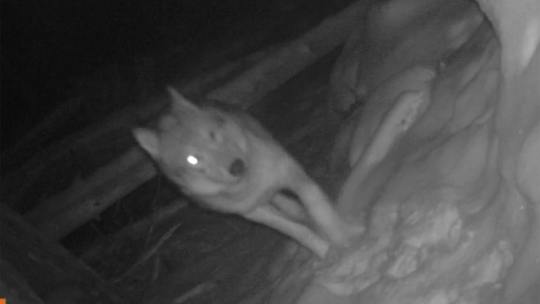
Wolf 907F, Yellowstone's aging matriarch at 11 years old, only has one eye. She's the fourth wolf to pass by this trail cam. (Courtesy Yellowstone Wildlife Project)
What makes Wolf 907F even more impressive is that she does all of this with only one functioning eye. Researchers aren't sure what happened, but her left eye has been small and sunken since before she turned 4. "You would never know [when] watching her," Cassidy said.
Like other elders, Wolf 907F takes a back seat in hunts now that she's older, and she spends most of her day hanging around with the pack's pups. Cassidy and her colleagues have counted three pups in her current litter, which is smaller than the average litter size of four to five but not surprising. A 2012 study of Yellowstone wolves published in the Journal of Animal Ecology found that litter size declines with age.
"The fact that 907 is still having pups is amazing, and her litter being small is expected given that she is so old," Cassidy said.
A few of Wolf 907F's offspring now lead packs of their own, but most of her pups never reach adulthood due to the perilous nature of being a wolf. However, Wolf 907F and the others in the park don't seem to live like death is on their mind.
"They are happy to be with their family going from day to day," Cassidy said. "Even if they have injuries or are missing an eye or something really stressful is going on in their life, they move through that stress and go back to seemingly really enjoying their life."
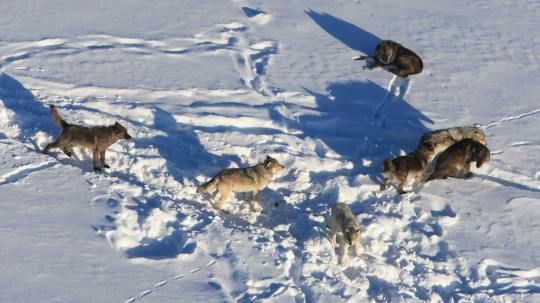
At age 11, Yellowstone's Wolf 907F - the gray wolf in the center of this photo from 2020- has lived more than double the typical lifespan of wolves in the wild. (Courtesy Yellowstone Wildlife Project)
#Sorry for kinda letting this blog die. It is something I intend to bring back eventually I promise.#Have this in the meantime.#gray wolf#gray wolves#wolf#wolves#specific wolves#<- new tag I guess for talking about specific individuals rather than the species as a whole
33K notes
·
View notes
Text
Sorry for the lack of posts lately; I've been caught up with other things. I will restock the queue eventually.
#I also used up a bunch of the easy facts quickly early on so finding new and unique facts is hard at times#housekeeping#not a fact
10 notes
·
View notes
Text
The top of a wolf's head is fairly flat, not rounded or pointed.
31 notes
·
View notes
Text
The position of a wolf's tail can indicate its emotions or level of dominance. A wolf with its tail raised high is very assertive or aggressive; the higher the tail, the more dominant it is trying to appear. A wolf with its tail tucked in beneath its body is usually displaying submissive behavior or fear, and much like with a raised tail, the degree of tuck indicates the level of fear or submission. A slight tuck may signal casual submission or uncertainty, whereas the tail pressed all the way to the belly may signal extreme fear or appeasement. Of course, the other body language, facial expression, and vocalizations of the individual should also be taken into account when analyzing what a wolf is trying to communicate.
23 notes
·
View notes
Text
A wolf's tail helps it to balance, especially when moving. The movement of the tail will counter the movement of the body, reducing side-to-side sway on the animal. A wolf will also use its tail as a counter-balance when turning, allowing sharper movements and less energy usage.
15 notes
·
View notes
Text
A wolf's lower canine teeth are farther forward in the mouth than its upper canine teeth.
13 notes
·
View notes
Text
While wolves let their tails hang down at rest, they often raise them to be near-horizontal when running.
17 notes
·
View notes
Text
Wolves have distinct cheek ruffs, that is, tufts of fur that flows off the sides of their faces. This leads to the head looking more diamond shaped, and even larger than it actually is.
22 notes
·
View notes
Text
Tail-wagging is involved in many wolf behaviors. In addition to the practical back-and-forth movement to help balance when moving, it is also often a social cue. Wolves that wag their tails stiffly, like a pendulum swinging side-to-side, are often doing so out of excitement. Wolves that wag their tails fluidly, with a snake-like movement, are often doing so as part of greeting or play. Excessive wagging can also be a sign of submission, and may cross over with the tail-wagging of greeting.
19 notes
·
View notes
Text
Wolves have scent glands between the pads of their paws. To spread the scent, they may repeatedly scratch or kick the ground, particularly with their hind paws, and often after urinating or defacating. This is fittingly called scraping or ground scratching. Like many other scent spreading behaviors, this is often used to mark territory, claim something in the area as the wolf's own, or leave an announcement of their presence.
17 notes
·
View notes
Text
Before a wolf has pups, it will first find or make a den to have them in (or some mix of the two). A mother wolf wants somewhere safe to give birth and to raise the pups for the first few weeks of their lives, while they are still weak and vulnerable. Factors that influence the den site include: distance from the edge of the pack's territory, proximity to water, canopy cover, and surrounding vegetation or terrain that can obscure the den entrance. Many wolf dens are dug out under fallen logs or large rocks, probably because they provide a roof with a strong structure.
25 notes
·
View notes
Text
Wolf pups and yearlings will lick or stick their snouts in the corners of older wolves' mouthes, which triggers them to regurgitate food for the pups to eat. Wolves will also regurgitate food for a pack member who is pregnant or nursing, and therefore cannot hunt with the rest of the pack. They may also regurgitate food for other adult pack members, but this is significantly less common.
22 notes
·
View notes
Text
Eye contact (or lack thereof) is part of how wolves communicate. Direct, prolonged eye contact can be a sign of aggression or dominance, whereas pointedly avoiding eye contact is an appeasement behavior, signaling that the wolf does not want to have any trouble. In the most dramatic cases of the latter, the wolf will open its eyes wide and look away so that the white of the eye is visible (this is called "whale eye," especially when referring to dogs). Displays of aggression aren't the only time wolves make eye contact though. Wolves often make eye contact when greeting each other, or any other time they want to assess how the other wolf is feeling by reading their facial expression.
76 notes
·
View notes
Text
When a wolf's moth is closed, its canine teeth are long enough overlap the gums of the opposite jaw, rather than stopping at the height of the teeth of the lower jaw.
21 notes
·
View notes
Text
A wolf has a relatively large head in relation to its body.
17 notes
·
View notes
Text
When a wolf comes across a strong- or unique-smelling object or scent, it may roll in it. This is called scent rolling. We aren't certain of the reason or reasons for this behavior, but some theories are: a) the wolf using the strong scent as olfactory camouflage, using it to cover their own scent so that prey animals don't recognize it as easily, b) the wolf claiming the item as its own by mixing their scents together, or c) the wolf wanting to carry an interesting or useful scent back to its pack members, and convey some information about what it's found.
44 notes
·
View notes
Text
Sometimes a wolf will jab at a potential food item with its nose and jump back before taking the first bite. It does this to make sure that whatever it is about to eat is dead, or at least unable to fight back or injure the wolf in any way.
20 notes
·
View notes